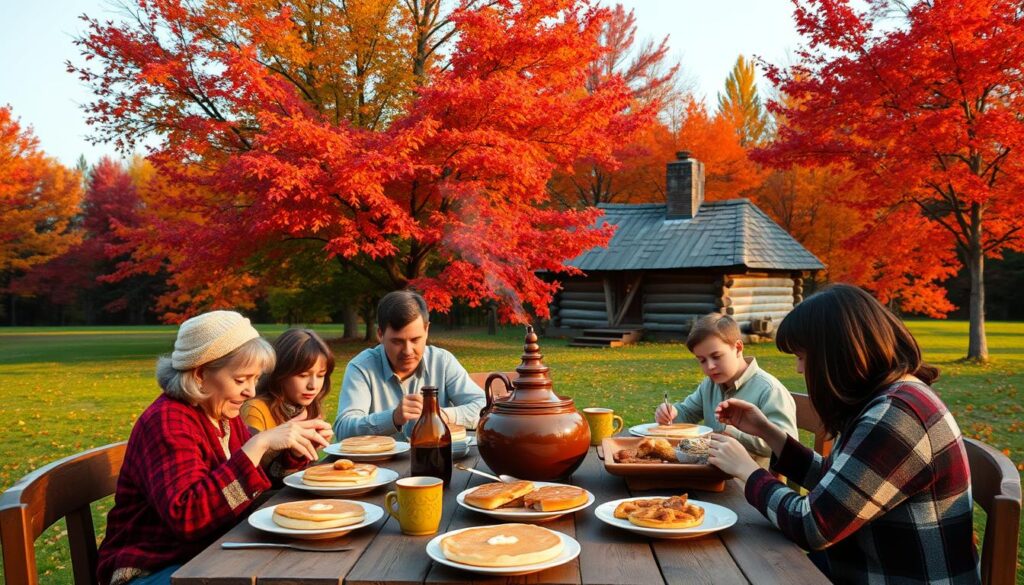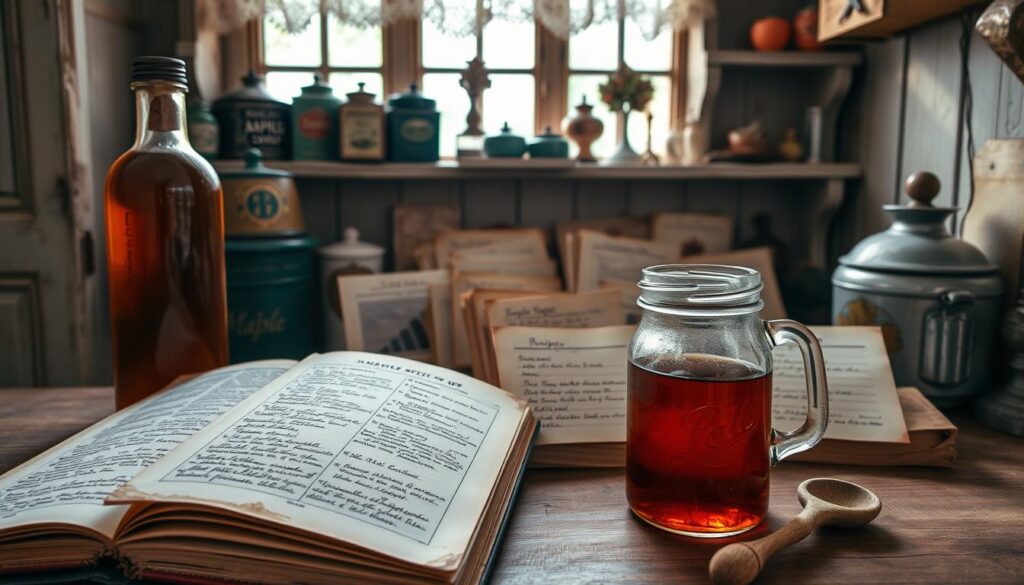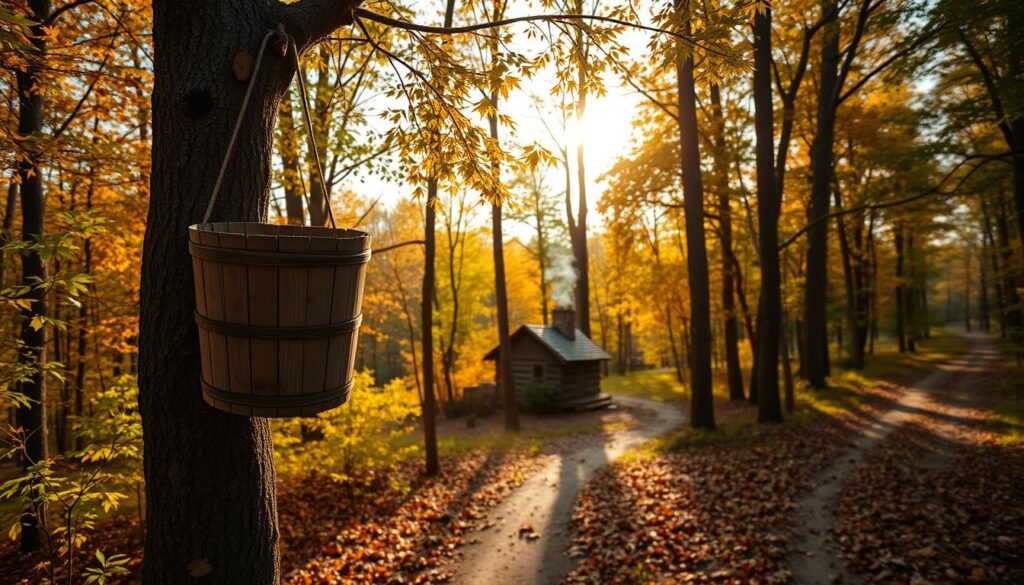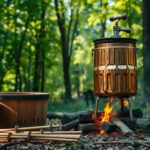Maple syrup is more than a tasty topping for pancakes. It tells a story of North American traditions. This history goes back centuries, filled with discovery, innovation, and culinary art.
Indigenous peoples first found the sweet sap in maple trees. They learned to extract and process it long before Europeans came. Their deep understanding of forests and seasons turned maple syrup into a valuable item.
Early settlers saw the value of this natural sweetener. They learned how to preserve it from Native Americans. This exchange of knowledge changed maple syrup history, blending old traditions with new technologies.
Over time, making maple syrup has changed from simple collection to advanced techniques. Sugarmakers have kept their traditions alive while using new technology.
Now, maple syrup shows the power of sustainable farming. It’s a mix of nature and human creativity. Its journey from forest to table inspires many in North America and around the world.
The Origins of Maple Syrup: Native American Heritage
The story of Maple Syrup starts with Native Americans in North America. They first turned maple tree sap into a sweet, nutritious food. Before European settlers came, Native tribes had already learned how to make maple syrup. They used methods that are the base of syrup making today.
Indigenous Peoples’ Discovery of Maple Sap
Native American tribes in the northeastern woodlands were the first to find maple trees’ sweet sap. Legends tell of accidental discoveries, where hunters and gatherers saw animals drinking sap from broken branches. They also noticed sap boiling when cooking fires were lit.
- Woodland tribes like the Algonquin and Iroquois first recognized maple sap’s unique properties
- They observed animals consuming tree sap during early spring seasons
- Initial collection methods involved simple wooden tools and natural containers
Traditional Collection Methods
Native communities created detailed ways to collect maple syrup using what nature provided. They made V-shaped cuts in maple bark and used wooden spouts to guide sap into birch bark containers or logs.
- Stone tools were used to create precise tree incisions
- Birch bark containers collected and stored maple sap
- Heated stones were used to boil and concentrate the sap
Cultural Significance in Native Communities
Maple syrup was more than food for Native peoples. It was a deep connection to nature, important for nutrition, trade, and spiritual practices. The maple sap harvest was a time for community, celebrating the seasons and helping through winter.
The maple tree was not just a resource, but a sacred provider that connected generations through its sweet gift.
Early Colonial Adoption and Development
The Maple Syrup History took a big leap when European settlers met Native American sap extraction. Native Americans had been making maple syrup for a long time. Colonists saw the value in this natural sweetener.
Settlers learned how to make maple syrup from Native Americans. They used new tools and methods to improve production. This changed maple syrup forever.
“The sweet liquid of the maple tree became a vital sweetener in colonial households, replacing expensive imported sugar.” – Historical Agricultural Records
- Colonists adopted wooden spile and bucket collection methods
- Maple syrup became a critical local economic resource
- Production techniques evolved from indigenous practices
- Maple sugar emerged as an affordable alternative to Caribbean sugar
In colonial times, maple syrup production was a big leap forward. Settlers used iron kettles to boil sap into syrup and sugar. This way, they could keep the syrup for longer.
By the late 18th century, maple syrup production was key in northeastern North America. Families would come together in spring. They would turn maple sap into syrup, helping communities through cold winters.
The Science Behind Maple Trees and Sap Production
Pure Maple Syrup starts with the science of maple trees. These trees have special traits that make them perfect for syrup. The mix of tree biology, climate, and environment is key for syrup making.
The sugar maple tree is the main source of syrup. It’s known for its great sap production. These trees have special ways to store and move sap through their systems.
Sugar Maple Biology
Sugar maple trees have special features for sap making. Their inside has special tissues that:
- Store carbs in winter
- Help sap move
- Keep sap safe from extreme temps
Optimal Climate Conditions
Good syrup making needs the right environment. The best climate has:
| Climate Factor | Optimal Conditions |
|---|---|
| Temperature Range | 32-45°F (0-7°C) |
| Seasonal Variation | Distinct freeze-thaw cycles |
| Geographical Location | Northeastern North America |
Sap Flow Mechanics
Sap movement is a cool process. It happens when night gets cold and day gets warm. This makes the tree pump sap out. Positive root pressure and temperature changes help sap flow.
Learning about this science shows why maple syrup is more than sweet. It’s a sign of maple trees’ amazing design.
Traditional Maple Syrup Harvesting Techniques
Traditional maple syrup harvesting is a craft that links generations to the magic of turning tree sap into syrup. Native Americans first mastered this art, creating methods that today’s farmers follow.
The traditional maple syrup harvesting process includes several key steps:
- Identifying mature sugar maple trees with optimal sap production
- Carefully drilling precise tap holes using hand-powered augers
- Inserting wooden or metal spiles to direct sap flow
- Collecting sap in wooden buckets hung directly on trees
Timing is everything in traditional maple syrup harvesting. Sugarmakers look for specific winter-to-spring temperature patterns. These patterns make sap flow perfect.
The hardest part of traditional maple syrup harvesting is boiling the sap. Historically, large iron kettles were used over open wood fires. This process needed constant attention and hours to concentrate the sap into syrup.
Each drop of maple syrup represents hours of meticulous work and deep connection to the forest ecosystem.
Traditional maple syrup harvesting shows the skill and patience needed to make syrup. These methods, kept alive through generations, inspire today’s maple syrup makers.
Evolution of Maple Syrup Production Methods
Maple Syrup Production has seen big changes, showing the industry’s love for new ideas and doing things better. It’s moved from old ways to new ones, keeping the tradition alive.
Old days of making maple syrup were hard work. People used simple tools and took a lot of time to collect sap.
From Wooden Buckets to Pipeline Systems
Collecting sap used to mean hanging buckets on trees and checking them often. Now, we use better systems that make it easier and faster.
- Pipeline networks connect multiple maple trees
- Vacuum-assisted sap collection increases yield
- Reduced labor requirements
- Minimized forest disruption
Modern Evaporation Technologies
New tech has changed how we process sap, making it more efficient and accurate. We use systems like reverse osmosis and high-efficiency evaporators instead of old ways.
| Technology | Efficiency Improvement | Energy Savings |
|---|---|---|
| Reverse Osmosis | 75% water removal | 50% fuel reduction |
| Advanced Evaporators | Faster processing | 40% time savings |
Sustainable Harvesting Practices
Today, making maple syrup is all about caring for the environment. We use methods that keep the forest healthy and syrup production good.
- Selective tree tapping
- Forest regeneration strategies
- Limited tap hole diameter
- Rotational tapping techniques
These changes show how the maple syrup industry cares about both new tech and the planet.
Understanding Pure Maple Syrup Grades

Pure maple syrup is a culinary treasure with a special grading system. This system shows the syrup’s unique qualities. It helps people know the flavor and color differences made at different times of sap harvesting.
The grading of pure maple syrup is designed to highlight its special qualities. Sugarmakers sort syrup by color and flavor.
- Golden Color with Delicate Taste: Harvested early, this grade has a light, subtle maple flavor
- Amber Color with Rich Taste: A medium syrup with a stronger maple taste
- Dark Color with Robust Taste: Collected later, it has a stronger, more intense maple flavor
- Very Dark with Strong Taste: The most concentrated syrup, great for strong flavors
Each maple syrup grade shows a special moment in the maple tree’s season. The time sap is collected affects the syrup’s color and flavor.
| Maple Syrup Grade | Color | Flavor Intensity | Harvest Timing |
|---|---|---|---|
| Golden | Lightest | Delicate | Early Season |
| Amber | Light Brown | Rich | Mid Season |
| Dark | Medium Brown | Robust | Late Season |
| Very Dark | Darkest | Strong | End of Season |
Knowing about maple syrup grades helps cooks and bakers choose the right syrup. It ensures a true and rich maple taste in their dishes.
The Canadian Maple Syrup Industry Today
The Canadian Maple Syrup Industry is a global leader in sweet agricultural production. Quebec is at the forefront, producing most of the world’s maple syrup. This industry is more than just a tasty export; it’s a key economic driver for Canadian farmers.
The economic strength of the Canadian Maple Syrup Industry is impressive. Producers in Quebec and other provinces have turned traditional sap harvesting into a modern, valuable industry.
Economic Impact Breakdown
Canadian maple syrup production brings in big economic benefits:
- Annual revenue over $500 million
- Supports over 11,000 maple syrup producers
- Creates thousands of jobs, both seasonal and permanent
- Has a strong export market in North America and worldwide
Global Market Position
Canada leads the global maple syrup market, producing about 71% of the world’s syrup. The industry’s focus on quality and sustainability has made it well-known internationally.
| Year | Production Volume (Gallons) | Export Value |
|---|---|---|
| 2020 | 13.2 million | $487 million |
| 2021 | 14.5 million | $542 million |
| 2022 | 15.8 million | $618 million |
Production Statistics
The Maple Syrup Industry is growing, thanks to new technologies and sustainable practices. Quebec’s Federation of Maple Syrup Producers is key in setting standards and planning production.
The Canadian Maple Syrup Industry is a mix of traditional craftsmanship and modern agricultural innovation.
Maple Syrup History: From Forest to Table
The history of maple syrup is truly captivating. It started as a forest product used by Native Americans. They found a way to make maple sap sweet, which later changed how we make syrup today.
Back then, making maple syrup was hard work. People had to go deep into the forest. They looked for sugar maple trees and got their sap.
- Indigenous peoples used wooden tools for initial sap collection
- Early settlers learned extraction techniques from Native American communities
- Handcrafted wooden buckets were primary collection vessels
Over time, making maple syrup got a lot easier. We went from using old wooden buckets to modern pipeline systems. This change made syrup better and easier to make.
| Era | Collection Method | Production Capacity |
|---|---|---|
| Pre-1850 | Wooden Buckets | Limited Local Use |
| 1850-1950 | Metal Buckets | Regional Distribution |
| 1950-Present | Pipeline Systems | Global Commercial Production |
Maple syrup became famous worldwide. New ways to package and sell it helped it reach more people. Now, it’s enjoyed everywhere, not just in maple syrup areas.
Maple syrup is more than just a sweetener. It shows how humans innovate and care for nature.
Cultural Impact and Culinary Heritage

Maple syrup is more than just a sweetener. It’s a symbol of North American traditions. Recipes from the past have shaped the food of Canada and the northeastern United States.
Maple syrup’s role goes beyond breakfast. Indigenous communities first used it, creating ways to make sap into syrup. Their recipes changed cooking over time.
- Maple syrup festivals celebrate regional cultural traditions
- Sugar shacks represent important community gathering spaces
- Regional cuisines incorporate maple syrup in unique ways
Maple syrup touches community celebrations and cooking. It goes from traditional Indigenous dishes to modern gourmet recipes. This shows how North American food culture keeps changing.
| Region | Cultural Significance | Typical Maple Syrup Uses |
|---|---|---|
| Quebec, Canada | National Culinary Identity | Desserts, Savory Dishes |
| Vermont, USA | Agricultural Heritage | Baking, Glazes |
| New Brunswick, Canada | Community Festivals | Traditional Cooking |
The maple leaf symbolizes Canada, showing syrup’s cultural importance. These recipes are more than food. They connect us to land, tradition, and community.
Modern Production Challenges and Solutions
The maple syrup industry is facing big challenges. Climate change is a major factor, changing how sugarmakers harvest and process maple sap.
Climate Change Impacts on Maple Syrup Production
Maple syrup production is under environmental pressure. Weather changes are making tapping seasons unpredictable. This means shorter and less reliable sap collection periods for sugarmakers.
- Reduced winter cold spells interrupt sap flow cycles
- Increased temperature variability affects tree health
- Shorter freezing periods limit maple syrup yield
Industry Technological Adaptations
New technologies are helping maple syrup producers deal with climate issues. Advanced monitoring and precision agriculture improve sap collection and tree care.
“Adaptation is key to preserving our maple syrup heritage” – Vermont Maple Sugar Makers Association
Future Sustainability Strategies
The maple syrup industry is focusing on long-term sustainability. Research and planning are underway to develop more resilient maple trees. This will help them adapt to changing environments.
- Developing climate-resistant maple tree varieties
- Implementing advanced forest management techniques
- Creating climate adaptation protocols
These efforts show the maple syrup community’s dedication to keeping this tradition alive, even with environmental challenges.
Health Benefits and Nutritional Value
Pure maple syrup is a natural sweetener with amazing nutritional benefits. It’s different from refined sugars because it offers more than just sweetness. The special mix in pure maple syrup brings health perks that make it a great choice over other sweeteners.
Nutrition experts have found key elements that set pure maple syrup apart:
- Rich in essential minerals like manganese and zinc
- Contains powerful antioxidants that fight cellular damage
- Provides phenolic compounds with anti-inflammatory properties
The minerals in pure maple syrup make it very nutritious. Just one serving can give you a lot of important nutrients you need every day.
| Nutrient | Amount per 1/4 Cup | % Daily Value |
|---|---|---|
| Manganese | 0.7 mg | 33% |
| Zinc | 0.4 mg | 3% |
| Calcium | 20 mg | 2% |
Even though pure maple syrup is sugar, it’s better than artificial sweeteners. It has polyphenols that might help protect against long-term diseases.
Nutrition experts say pure maple syrup is a better choice than processed sugars.
For those looking for a healthier sweetener, pure maple syrup is a good pick. Using it instead of refined sugars can add nutritional value while meeting sweet cravings.
Historical Maple Syrup Recipes and Uses
Maple syrup has a long history, from ancient traditions to today’s kitchens. It has evolved from a simple forest product to a key ingredient in many dishes. This journey shows how maple syrup has become a staple in cooking.

Native American communities were the first to make maple syrup. They created unique ways to use it, influencing European settlers later. Their recipes went beyond just sweetening, adding depth to their cooking.
Traditional Preparations
Indigenous chefs were masters at using maple syrup. They made:
- Maple sugar
- Maple glazes for meats
- Medicinal syrups
- Maple-based drinks
Colonial-Era Recipes
European settlers soon started using maple syrup in their cooking. They mixed old recipes with new ingredients, creating tasty dishes.
- Maple puddings
- Maple-sweetened breads
- Maple-cured meats
Modern Culinary Applications
Today, chefs use maple syrup in many ways, making it a key ingredient. It’s used in everything from desserts to savory dishes. This shows how maple syrup has become a true art form in cooking.
“Maple syrup is not just a sweetener, but a connection to centuries of culinary tradition.” – Chef Michael Krupp
Maple syrup’s lasting impact shows that some ingredients truly stand the test of time. It connects us to the past, making our food more meaningful.
Global Maple Syrup Trade and Economics
The Maple Syrup Industry is a fascinating economic scene that covers many continents. North America leads in production, with Canada and the United States at the top in maple syrup exports.
Big players in the Maple Syrup Industry have built strong trade networks. These networks turn old forest harvesting into a big economic force. Quebec makes about 72% of the world’s maple syrup, which boosts Canadian agriculture a lot.
- Global maple syrup market value: $1.5 billion annually
- Primary producing regions: Canada and Northeastern United States
- Growing international demand in European and Asian markets
The Maple Syrup Industry faces challenges like climate change and changing production costs. There are also complex international rules to follow. Sugarmakers must deal with these issues while keeping their products high quality and competitive in the market.
| Country | Annual Production (Gallons) | Market Share |
|---|---|---|
| Canada | 8.5 million | 75% |
| United States | 2.5 million | 25% |
International trade deals and setting quality standards are key to growing the Maple Syrup Industry worldwide. New markets in Asia offer big chances for North American producers.
“Maple syrup is not just a condiment, it’s a complex global commodity with complex economic dynamics.” – Canadian Agricultural Experts
Preserving Traditional Methods in Modern Times
The art of Traditional Maple Syrup Harvesting is at a turning point. It’s caught between new technology and keeping traditions alive. Sugarmakers in North America are working hard to keep maple syrup’s rich history alive. They’re doing this while facing today’s challenges.
Artisans are dedicated to keeping maple syrup’s traditional ways alive. They want to make sure these old methods stay strong, even as food production gets more industrial.
Artisanal Production Strategies
Artisanal maple syrup makers stick to true Traditional Maple Syrup Harvesting methods. They connect with history in their work. Here’s what they do:
- Hand-tapping maple trees with old tools
- Using small batches for processing
- Keeping tech use to a minimum
- Keeping family knowledge alive
Educational Initiatives
Cultural places are key in teaching Traditional Maple Syrup Harvesting. They offer hands-on learning experiences.
| Educational Program | Target Audience | Key Focus |
|---|---|---|
| Living History Workshops | Students and Families | Hands-on Maple Syrup Production |
| Sugarhouse Demonstrations | Tourists and Enthuasiasts | Traditional Processing Techniques |
| Historical Preservation Programs | Researchers and Historians | Documentation of Cultural Practices |
Heritage Conservation Efforts
Museums and cultural groups are collecting important items. They’re also gathering stories and documents. This is to keep maple syrup knowledge alive for the future.
Preserving Traditional Maple Syrup Harvesting is more than just keeping records. It’s about keeping a living cultural tradition alive.
Conclusion
Maple syrup’s history is a fascinating journey from ancient discovery to today’s global favorite. It spans centuries of cultural traditions, technological leaps, and a deep bond with North America’s landscapes. From Native American early methods to today’s advanced techniques, maple syrup is more than a sweetener. It’s a living heritage.
The making of maple syrup shows resilience and adaptability. Sugarmakers face challenges like climate change and market shifts. Yet, they keep traditional knowledge alive. Each maple syrup drop holds the forest’s essence and the wisdom of generations.
Looking ahead, maple syrup symbolizes cultural identity and caring for the environment. As it gains worldwide appeal and production improves, it showcases human creativity and respect for nature. The maple syrup story is about connecting people, land, and the seasons.
The future of maple syrup looks bright, with growing global interest and new ways to make and preserve it. As people seek real, eco-friendly foods, maple syrup stands out. It’s a top-notch, natural treat with deep roots in North American food culture.



